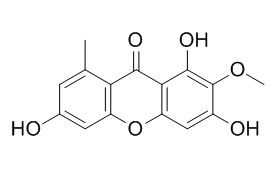Drimiopsin C
Drimiopsin C is a natural product from Scilla scilloides.
Inquire / Order:
manager@chemfaces.com
Technical Inquiries:
service@chemfaces.com
Tel:
+86-27-84237783
Fax:
+86-27-84254680
Address:
1 Building, No. 83, CheCheng Rd., Wuhan Economic and Technological Development Zone, Wuhan, Hubei 430056, PRC
Providing storage is as stated on the product vial and the vial is kept tightly sealed, the product can be stored for up to
24 months(2-8C).
Wherever possible, you should prepare and use solutions on the same day. However, if you need to make up stock solutions in advance, we recommend that you store the solution as aliquots in tightly sealed vials at -20C. Generally, these will be useable for up to two weeks. Before use, and prior to opening the vial we recommend that you allow your product to equilibrate to room temperature for at least 1 hour.
Need more advice on solubility, usage and handling? Please email to: service@chemfaces.com
The packaging of the product may have turned upside down during transportation, resulting in the natural compounds adhering to the neck or cap of the vial. take the vial out of its packaging and gently shake to let the compounds fall to the bottom of the vial. for liquid products, centrifuge at 200-500 RPM to gather the liquid at the bottom of the vial. try to avoid loss or contamination during handling.
J Ethnopharmacol.2024, 326:117902.
Industrial Crops and Products2022, 186:115298
Clin Exp Pharmacol Physiol.2015, 42(11):1189-97
Int. J. Mol. Sci.2023, 24(20),15294.
Environ Toxicol.2020, doi: 10.1002
Int J Mol Sci.2015, 16(8):18396-411
Front Immunol.2020, 11:598556.
Pharmaceuticals (Basel).2024, 17(6):727.
J Ethnopharmacol.2018, 210:88-94
Oxid Med Cell Longev.2021, 2021:6647107.
Related and Featured Products
3,6-Dihydroxy-1,7-dimethoxyxanthone
Catalog No: CFN89303
CAS No: 262292-34-2
Price: Inquiry(manager@chemfaces.com)
Onjixanthone II
Catalog No: CFN89276
CAS No: 136083-93-7
Price: Inquiry(manager@chemfaces.com)
6-Hydroxy-1,2,3,7-tetramethoxyxanthone
Catalog No: CFN89282
CAS No: 64756-87-2
Price: Inquiry(manager@chemfaces.com)
1,2,3,6,7-Pentamethoxyxanthone
Catalog No: CFN89241
CAS No: 64756-86-1
Price: Inquiry(manager@chemfaces.com)
Angustin A
Catalog No: CFN89373
CAS No: 1415795-50-4
Price: Inquiry(manager@chemfaces.com)
Angustin B
Catalog No: CFN89374
CAS No: 1415795-51-5
Price: Inquiry(manager@chemfaces.com)
7,8,9-Trimethoxy-10H-1,3-dioxolo[4,5-b]xanthen-10-one
Catalog No: CFN98533
CAS No: 24562-58-1
Price: Inquiry(manager@chemfaces.com)
1,5,6-Trihydroxy-3,7-dimethoxyxanthone
Catalog No: CFN89047
CAS No: 65008-02-8
Price: Inquiry(manager@chemfaces.com)
1,5,6-Trihydroxyxanthone
Catalog No: CFN89364
CAS No: 5042-03-5
Price: Inquiry(manager@chemfaces.com)
1,5,6-Trihydroxy-3-methoxyxanthone
Catalog No: CFN89549
CAS No: 50868-52-5
Price: Inquiry(manager@chemfaces.com)
Chinese Traditional & Herbal Drugs,2014 ,45 (14):1984-8.
Chemical constituents from Scilla scilloides[Reference:
WebLink]
To study the chemical constituents from Scilla scilloides.
METHODS AND RESULTS:
The chemical constituents were isolated and purified by column chromatography and their structures were identified by spectral data. Eighteen compounds were isolated from S. scilloides. Their structures were identified as scillascillin(1), 2-hydroxy-7-O-methylscillascillin(2), 4′-demethyleucomin(3), 5-hydroxy-7-methoxy-3-(4-hydroxybenzylidene) chroman-4-one(4), 4′-demethyl-3, 9-dihydroeucomin(5), 3′-hydroxy-3, 9-dihydroeucomin(6), 8-O-demethyl-7-O-methyl-3, 9-dihydropunctatin(7), apigenin(8), luteolin(9), chrysoeriol(10), 3-dehydro-15-deoxoeucosterol(11), 15-deoxoeucosterol(12), 4-allylpyrocatechol(13), norlichexanthone(14), Drimiopsin C(15), 6-feruloylcatalpol(16), catalposide(17), and specioside(18).
CONCLUSIONS:
Iridoids(16—18) are isolated from the genus Scilla L. for the first time. Compounds 4, 7—10, and 13—18 are isolated from the plants of this genus for the first time.
J Nat Prod. 2004 Oct;67(10):1726-8.
Xanthones from Drimiopsis maculata.[Pubmed:
15497949 ]
METHODS AND RESULTS:
Six new xanthones, drimiopsin A, drimiopsin B, Drimiopsin C, drimiopsin D, drimiopsin E, drimiopsin F , have been isolated from the South African Drimiopsis maculata.
CONCLUSIONS:
The structures of these compounds were difficult to elucidate due to the lack of correlating protons seen in the NMR spectra, and INADEQUATE spectra were used to confirm the structures. Xanthones have not previously been reported from the Hyacinthaceae.



